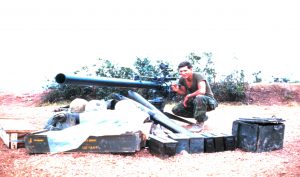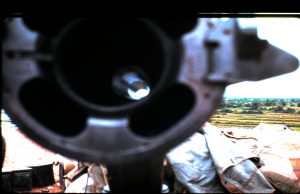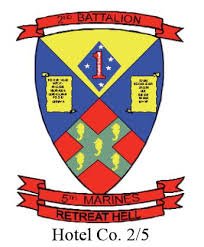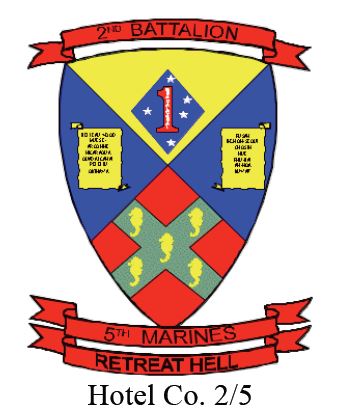
I am looking down the sights of an M40 106mm recoilless rifle sitting on the south end of Hill 65 in September 1969. In front of me is both a beehive round and a heat round. When our troops spot some NVA or VC in the area, these rounds are fired at them.
The M40 is shaped like a long tube with an M8C .50 cal spotting rifle above. The spotting rifle fires around whose trajectory closely matches that of the 105 mm round and gives off a puff of smoke on impact with the target. On the left side, there is an elevating wheel, in the center of which is the trigger wheel used to fine-adjust the elevation and at the same time firing the spotting rifle when pulled, and the gun when pushed. The mounting is a tripod, but the front leg has a castering wheel. On top of the mount is a traverse wheel. On the center of the traverse wheel is a locking wheel, when the wheel is down, the rifle is locked in traverse, and can only be moved right and left with the traverse wheel. When the wheel is raised, the rifle can be traversed by hand.
The M40 fires single-piece ammunition, of which many types are available. Ammunition for the 105 mm rifle was issued as one-piece fixed cartridges. The term “fixed” means that the projectile and the cartridge case are crimped together. This ensures the correct alignment of the projectile and the cartridge case. It also permits faster loading because the projectile and the cartridge case are loaded as one unit. The rear end of the cartridge case is perforated, to allow the propellant gas to escape through the vented breech, thus neutralizing recoil. Most projectiles (except HEAT) used are pre-engraved, that is, the rotating bands are cut to engage the rifled bore. If the round was not rotated slightly when loading the M40 it could result in jamming in the breech.
 Larry looking down the barrel of an M40 106mm Recoilless Rife overlooking the Arizona Territory on Hill 65.
Larry looking down the barrel of an M40 106mm Recoilless Rife overlooking the Arizona Territory on Hill 65.
The M40 was the final and largest iteration of the recoilless rifle in the American military service. Designed to fix the shortcomings of the 105mm M27 that preceded it, the M40 was light and powerful and added a .50 caliber 12.7mm spotting rifle to assist in being able to make first-round hits. The massive backlist of a recoilless rifle dictates that a crew generally only has one chance to make a hit before they must relocate to avoid retaliatory fire. Due to its excellent firepower, ample choice of ammunition types, and good range the M40 was a very successful weapon.
A wide variety of ammunition types is available for the M40 and each has its own effective range and performance. HEAT rounds can be considered the standard type of ammunition and are effective up to 1.350 meters and penetrate over 400mm RHA. Explosive rounds can be used up to 2 or 3 km and APERS rounds that fire flechettes up to 300 meters. The sustained rate of fire is 1 round per minute, although a rate of fire of 5 rpm can be attained for short periods. Beehive was a Vietnam war era anti-personnel round packed with metal flechettes fired from an artillery gun most popularly deployed during that conflict. It is also known as flechette rounds or their official designation, antipersonnel-tracer (APERS-T). Typically, artillery gunners fire using indirect fire upon enemy troops, firing at targets they cannot see by line of sight, with information provided by a forward observer.

